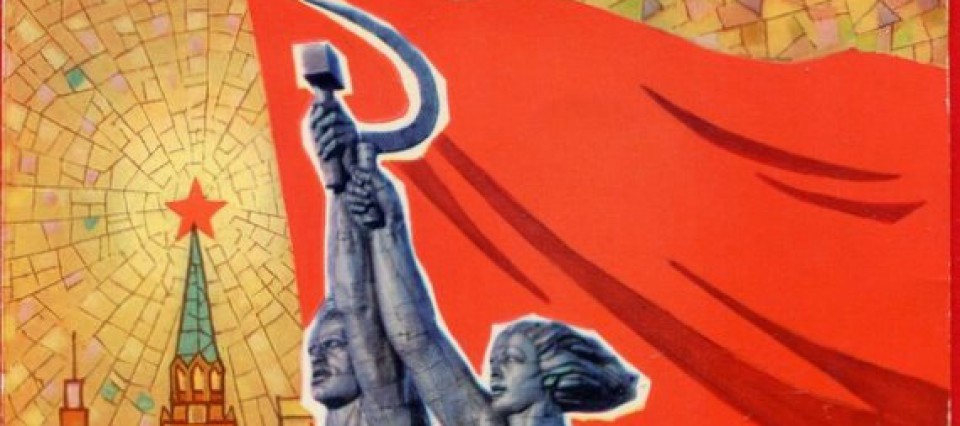
The Soviets found themselves with War at their doorstep. In 1941 the Germans had broken the Molotov-Ribbentrop Non-Aggression Pact of 1939 and began pouring millions of troops through the Western border of the Soviet Union. After two years of brutal fighting and heavy losses, the Soviets finally began to push the Nazis out of the USSR with the recapture of Stalingrad on February 2nd of 1943. Much of the Soviet’s military success can be attributed to the use of tanks.
Stalin took pride in his military, especially that of his tanks. When he was told to be wary of the power of the Vatican, he is quoted saying, “How many divisions does the Pope of Rome have?” Although humorous, his confidence in his tank divisions was without question. Likewise, the military posters of the time emulated Stalin’s tank obsession. Like the poster above, many posters were brutal and showed the sheer power of these new steel war machines.
The Battle of Kursk is known as the largest tank battle to date. The Germans consisted of 50 divisions, two tank brigades, three tank battalions, and eighty artillery assault divisions comprising 2,700 Tiger and Panther tanks, some 2,000 aircraft, and 900,000 men, while the Soviets consisted of 3,600 tanks, 2,800 aircraft, and 1.3 million troops. The battle led to a Soviet victory. It is highly debated whether or not D-Day or the Battle of Kursk was the downfall of the Nazis, but the battle itself is unquestionably one of the most significant battles of World War II. The following poster shows a disgruntled Hitler upset that he lost his “little ring (and there’s twenty-two divisions in the ring).” The ring being the area around the Battle of Kursk that was previously German occupied, and his twenty-two divisions is an estimate of his divisions that he lost. However, it is estimated that he may have lost upwards of thirty divisions.

The Soviet’s depended and loved their tanks during World War II and it is evident in their military victories and several propaganda posters. For the Soviets this was a war of steel. Steel that moved along treads and could shoot 76.2 mm rounds at the backs of retreating Nazis.
Sources:
http://www.allworldwars.com/Russian%20WWII%20Propaganda%20Posters.html
http://www.history.com/topics/world-war-ii/german-soviet-nonaggression-pact
http://www.secondworldwarhistory.com/soviet-union-ww2-events-timeline.asp

This was a good post that served to really capture the scope of the war well. It is hard to image a battlefield with over two million men meeting in combat. Given today’s military advancements, that type of total war may never be seen again. The Soviet T-34 was one of only a few tanks in the allies’ arsenal that could properly compete with the Nazi tanks of the war. Stalin had good cause to be proud in his armor. They were a fine example of a cutting edge battle-tank of that time.
LikeLike
I really enjoyed the posters, as well as the humorous Stalin quote. I liked how you followed up with the theme of military technology and industrialization from when we discussed tanks, tractors, and Pyriev’s film last week. After looking at the emergence of tanks in the preparation for the war effort in the 1930’s, this post exemplified Soviet’s application of their newest advantage and the success it provided during World War II.
LikeLike
Great post, I really liked that you included the specific numbers that the Russians and the Germans had. It really shows that even though Russia was beaten down, their sheer numbers mad them a force to be reckoned with. Russians seem to have always been proud of their industrial sector, so it makes sense that they put such an emphasis on tanks and held such pride in the number and quality of their tanks.
LikeLike
Great post! The use of tanks is an awesome representation of the adaptability and preparation the Soviet Army put in to their war time readiness. Like in previous posts, tanks were a large part of the military build up and they represent such a powerful aspect of a nations army at the time. The posters included and number comparison really helps clarify the subject and strengthen your argument.
LikeLike
This was an awesome post! It was very informative about the “other” major battle that is oft forgotten behind D-Day and Stalingrad. Your pictures were funny, but also showed the Soviet ideologies from back in the day. The Steel Curtain may have been winner on paper, but the Steel Avalanche tank divisions truly won the war for Stalin.
LikeLike